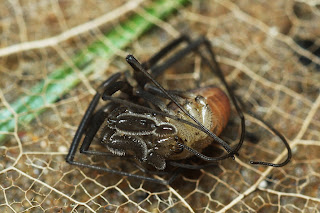28 August 2012
Sabacon
The rare British harvestman Sabacon viscayanum is, apart from populations in the western Pyrenees and adjacent areas, virtually confined to Wales (with just one or two records on the English side of the border with that country). It is particularly relevant to Gower as it was discovered as a British species by R.H.R. Abbot only in September 1980 at Parkmill. He was a student/staff member at Manchester University, helping the late myriapodologist Gordon Blower on one of his regular surveys on Gower. Since then, it has been found at quite a few other sites, mostly within Wales. Typically, Sabacon occurs under loose, flattish stones (often on the underside of the stone) in shaded, damp, rocky areas in incised `cwms`, but I`ve also had it under rotting wood in a willow carr-covered dune slack at Merthyr Mawr and in similar circumstances at Tywyn Burrows, Carmarthenshire. You have to look for this species -it does not occur out in the open on walls etc like many common harvestmen, and it is this secrecy, combined with its restricted geographical distribution, that perhaps led to its late discovery as a British species. On the Carboniferous limestone I`ve found it under deeply-embedded rocks in mossy, shaded ash woodland at two sites in Carms., and it was in this habitat that it was initially discovered at Parkmill. It is known from the outer part of caves in the Pyrenees, so a subterranean habitat suits it well. Incidentally, also look out for the hard-to-find and rare, cryptic harvestmen Trogulus tricarinatus (one record on Gower limestone) and Anelasmocephalus cambridgei (two records on Carms. limestone ridge); both `play possum` when disturbed and remain motionless -something that Sabacon can also do, before suddenly `coming alive` and running off surprisingly fast. One of Barry Stewart`s incredibly good photographs that accompany this note shows Sabacon `playing dead`.
Sabacon is out at present (and will be at least well into the winter, with young instars in Spring) and it would be good if more records could be made. It is small (body size, excluding legs, =<5mm) but distinctive with a vaguely brick-coloured body and blue-grey legs and, especially withs its `boxing-glove` pediplaps.
At first-and on unsubstantiated grounds- it was suggested by one of the early recorders (not the initial discoverer, though) that Sabacon was an introduction, as it was recorded near a quarry. As remarked previously, I suspect that it belongs to that suite of taxa that colonised the British Isles directly along the Atlantic seaboard, rather than via the `traditional` SE (North Sea/Dover etc) route. Anyone undertaking surveys in SW England and Eire ought to look out for this harvestman.
I thank Barry Stewart for his excellent photos - as he told me, he has now been afflicted by the `opilio-virus` (for which there is no known cure!).
Subscribe to:
Post Comments (Atom)




1 comment:
I forgot to add that the specimen photographed came from a wooded steep cwm just E of the Usk Reservoir, in Carms.
Post a Comment